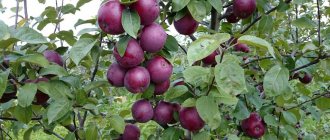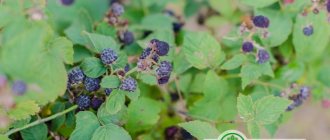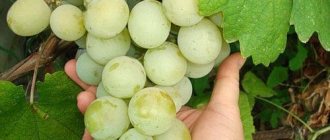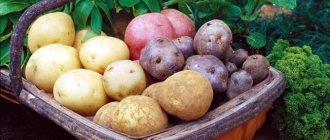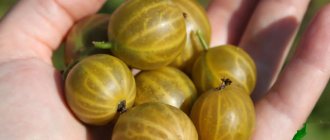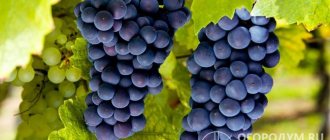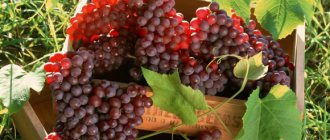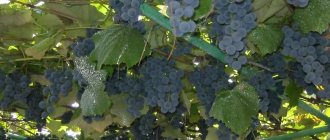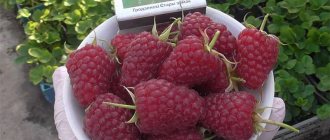Pleven nutmeg
- The ripening period of the first berries is 115-120 days (early ripening variety, ripens in the second decade of August);
- Wintering: frost-resistant;
- Dimensions: vigorous;
- Bunches: weight up to 475 g;
- Productivity: about 4.6 kg per bush;
- Berry: the shape of each medium-sized berry is oval, the color is light green, the pulp is nutmeg;
- Resistance against diseases and pests: average resistance, affected by spider mites.
The variety is well resistant to frost, withstanding temperatures down to -20 ° C, and is also quite resistant to mildew and gray rot.
Muscat resistant is a high-yielding variety that produces medium-sized, round, white berries. The pulp is fleshy and juicy, with a distinct nutmeg aroma, has a juice sugar content of 20%, and acidity of 4.6 g/l.
Medium sized cylindrical bunches, medium density. The harvest can be left on the bushes for a long time, it does not lose its properties, and high-quality juice and dessert wine are produced from it. The variety is frost-resistant, tolerates temperatures down to – 23-24 °C.
The variety is resistant to mildew and gray rot, and also has increased resistance to oidium.
Bulgarian table variety of early ripening.
Produces large berries measuring 26 x 24 mm, weighing 7-8 g, beautiful amber color and oval-oblong shape. The pulp of the berries is juicy, distinguished by high taste qualities with a pleasant muscat tone, the skin is thin. The variety is valued precisely for its pleasant nutmeg tone in the taste of the berries and very high sugar content. The sugar content of the juice can reach 21%. The berries are collected in large clusters weighing up to 500-600 g and even more.
The variety is productive, resistant to frost, and can withstand temperatures down to -23 °C. It has comprehensive disease resistance.
An early ripening variety, it produces large, elongated, ovoid berries weighing 6-7 g, amber-yellow in color. The sugar content of juice can reach 19%. Fleshy and juicy pulp with a nutmeg aroma. The berries are collected in large clusters weighing up to 400 g or more.
The variety is medium or tall, frost-resistant, tolerates temperatures down to -26 °C. Disease resistance is at an average level.
Super-Extra (Citrine)
| Sugar content of pulp (%) | Bunch weight (g) | Berry weight (g) | Ripening time (days) | Trimming (eyes) |
| 15-17 | 500-700 | 7-10 | 95-100 | 5-7 |
An extra-early table grape variety. The bushes are medium-sized, productive. Flowers of both sexes, that is, the variety is self-pollinating. In open ground, in a well-lit place, they ripen in mid-August. The clusters are large and pick up sugar well. Pea peeing appears to a slight extent. The berries are harmonious in taste, fleshy and juicy, large, white, when fully ripe - yellow, slightly ovoid.
Ripe berries have a tendency to wilt near the stalk. Therefore, the harvest must be harvested on time. The load on the bush is 20-30 buds when the length of pruning vines is 5-7 buds. The ripening of annual shoots is satisfactory. Resistance to fungal diseases at the level of 2-2.5 points. Frost resistance down to –25°C, requires shelter for the winter.
Grape varieties for central Russia
Grape varieties for central Russia, bred by breeders, mainly have such distinctive features as frost resistance and early ripening. Therefore, they successfully tolerate low temperatures, and fragrant, juicy fruits appear already in the third year after planting the vineyard.
Harold
This variety is recommended for all gardeners, as it ripens very early - by the end of July. Harold is popular because of its taste, it is very fragrant, and also because it is easy to care for.
It is distinguished by its high yield; up to 15 kg of fruit can be collected from one bush. The bunches are large and can retain their quality for a long time if not collected. The berries of this variety are oval, large, with a harmonious balance of sweet and sour taste, and have a subtle nutmeg aroma. They are used industrially to make some wines.
The shoots ripen early, which guarantees the next harvest. Harold perfectly resists diseases such as mildew, rot and oidium. Tolerates frosts down to -25 °C. A special feature of this variety is its abundant fruiting on the shoots, which makes it possible to get a harvest even if damaged by spring frosts. Transports well.
White miracle
The variety ripens in early August. The clusters are quite large - up to one and a half kilograms; they can remain on the vine for a long time, maintaining their properties. This variety has large white berries with juicy and fleshy pulp. They sing evenly, which is a distinctive feature of the White Miracle. The shoots ripen well.
The variety is highly resistant to diseases and frost (not lower than –25 °C). There is a drawback: annual shoots are brittle. Therefore, leave those that can be put under cover for the winter, and the rest should be trimmed. Transportability is low.
Beauty of Nikopol
Fruits abundantly every year, regardless of weather conditions. It is very resilient and is not afraid of damage and frost, as it grows rapidly in the spring, laying many inflorescences, and the shoots ripen well. Ripens very quickly: in just 110 days from the beginning of ovary formation.
The clusters are kilogram-sized, with large dark purple grapes, thin-skinned and pleasant to the taste. The variety successfully resists gray rot and mildew. It can be affected by oidium, so 2-3 times of fungicide treatment per season is necessary. Frost-resistant down to –22 °C. During transportation, it does not lose its external and nutritional qualities.
Laura
This variety ripens early - in the first ten days of August, and is distinguished by good ripening of the vine. The bunches are almost always one kilogram in size; with proper agricultural technology they can reach 3 kg.
Large white oval berries have a delicate, slightly sour taste; the seeds are easily separated from the pulp. The variety is resistant to diseases and frosts (up to -23 °C). Laura has an excellent presentation, because there are no small grapes, and they do not crack. Transports well.
Kishmish 342
Ripens with the beginning of August days, the first of all seedless varieties. The clusters are medium in size, the berries are egg-shaped, white, juicy and have a wonderful taste. The shoots ripen well.
The variety produces a rich, constant harvest. resists mildew and gray rot. It is moderately affected by oidium, which requires treatment with fungicides 2-3 times. Adapted to low temperatures (down to -25 °C). It is transported and stored well for two months, but does not tolerate transplantation well.
Which grape variety is best to buy?
Each of the presented types is distinguished by good taste, good harvest, and undemanding conditions of growth and care. All of them can be grown by both professional winegrowers and beginners.
The TOP 10 best varieties of berries include:
- Arcadia is a table type that carries the Cardinal and Moldova genes. It belongs to the early varieties and ripens in 115 to 125 days. Bushes are medium or vigorous. The cultivation of berries is widespread in central Russia due to frost resistance, including in the Urals.
- Kishmish is oval white - it is distinguished by small, neat berries of pale green color. Their characteristic feature is the absence of developed seeds and the presence of a thin skin, which is practically not felt when eating the fruit fresh.
- Pinot noir is a technical type of grape cultivated for the production of elite wines. It is grown in France, Italy, Spain, and America. In terms of morphological differences and biological characteristics, it is close to the ecological and geographical group from Western Europe.
- Baikonur - has a specific appearance: the berries are elongated, with a pointed end. Its key advantages: normal reaction to low temperatures and heat resistance; also, in the absence of high moisture levels, the fruits do not wrinkle and retain their sweet taste.
- Riesling - this type looks similar to white sultanas, but its green color is paler, and the berries are much larger. Their shape is the same round. Most often, they are used to produce environmentally friendly, dietary juices, dry, sparkling and strong wines. It grows in Bulgaria, France, Italy and a number of other countries.
- Cabernet Sauvignon is one of the most popular types among winemakers, belonging to the technical group. It comes from France and is cultivated in Bulgaria, Romania, the USA and many other countries of the world. Cabernet Sauvignon perfectly resists various pests: gray rot, bunch budworm, etc.
- In Memory of Negrul - interesting because of its marketable appearance and excellent keeping quality, which allows it to be successfully grown for mass sales. However, it is better not to consume this grape variety in large quantities for patients with diabetes due to the high concentration of sugars in the fruits - 14.3%.
- Isabella is the most scandalous type in the ranking, which has long been prohibited for cultivation for commercial purposes in the EU. The reason for the notoriety was the allegedly high concentration of methanol in the composition. However, it remains popular in private vineyards due to its low maintenance and lack of need for treatment with pesticides.
- Transfiguration is a hybrid obtained by combining the genes of Kishmish radiata and Talisman. It is valuable due to its early ripening period lasting 110-125 days. The berries are distinguished by their richness of taste and excellent presentation.
- Original - this name fully corresponds to the type of fruit: pink color, large size, elongated shape with a flattened end, beautiful bunch. It is grown both for themselves and for sale. The fruits are quite fleshy and juicy.
For planting for the purpose of eating fresh berries, preparing compote and juice for yourself, table grapes are usually planted
Those who are professionally engaged in winemaking are advised to pay attention to representatives of the technical group who were specially selected to produce wine, champagne, and raisins on a commercial scale
Here's what grape variety is good in different conditions:
- Arcadia, Baikonur, and Riesling are excellent for growing in central Russia.
- In the south of the Russian Federation (Krasnodar Territory and Dagestan) you can cultivate Kishmish oval white, Cabernet Sauvignon, Memory Negrul, Preobrazhenie.
- In the Moscow region, Original, Isabella and Pinot noir have proven themselves to be excellent.
Juodupe (Black River)
| Sugar content of pulp (%) | Bunch weight (g) | Berry weight (g) | Ripening time (days) | Trimming (eyes) |
| 14-16 | 150-200 | 3-3,5 | 95-100 | 4-6 |
The variety is unpretentious to soil composition. The load on the bush is 30-40 buds with a vine pruning length of 4-6 buds. Resistance to fungal diseases – 2.5-3 points. Frost resistance is very high - up to –30°C. These grapes can overwinter in a bent state under a layer of snow or light dry shelter. A universal variety with an extremely early ripening period of Lithuanian selection. Flowering type: bisexual. The clusters are small, conical, of medium density. The berries are small, round, dark blue. The taste is very delicate, with a light strawberry aroma, the skin is not noticeable when eating. The bushes are very vigorous, high-yielding (up to 4 bunches per shoot). The ripening of shoots is early and complete (100%).
Wine varieties of white grapes
Also check out these articles
- Decembrist flower (Schlumbergera)
- How to collect tomato seeds correctly
- Sunflower varieties
- Description of the Moscow black breed of chickens
White wine is made from white grape varieties. The method of making it differs significantly from the method of preparing red wine. Only the best technical varieties are used for these purposes.
- "Muscat" is one of the oldest species. The bunches grow up to 400 g. The berries weigh 3-4 g. Its main quality is the aroma with notes of cloves and roses, which gives the wine a special spice. Grown exclusively in southern regions with warm climates.
- “Sauvignon Blanc” is a famous grape variety of a universal type. Ripens in 130-135 days. Sugar content of berries is about 23%. These grapes make wine with a fruity or herbal aroma. Depending on the time of harvest, the berries may differ in taste and aroma - this is the main feature of Sauvignon Blanc.
Wine varieties of white grapes
Interesting! If Sauvignon Blanc is picked immediately after ripening, it will have herbal notes, and if some time after ripening, the berries will become full of sweetness and acquire fruity notes.
- “Crystal” is a high-yielding variety that ripens in 110-115 days. Brushes 170-220 g. Berries 1.5-2.1 g. Used in the production of sherry. The berries can withstand cold temperatures down to -29 degrees. Sugar content – 17-18%. This grape is often grown in Georgia, Moldova, and southern Russia. Resistant to gray rot, but can be affected by mildew and oidium. It needs proper care, otherwise the yield will decrease.
- Chenin Blanc is the oldest grape variety, which began to be processed back in the 9th century. Ripens in approximately 155 days. Today it is grown in America and South Africa, but wine is produced from this grape mainly in France. The drink made from Chenin Blanc is sour and has a floral-honey aftertaste. Productivity up to 70 c/ha.
Also, varieties such as Muscat Odessa, Semillon, Riesling, and Malvasia are often used to make white wine.
The best red grape varieties
Raisins and red wine are most often made from such grapes. It can be sweet or sour, depending on the amount of sugars in the berries. Most often, there are several seeds inside the fruit. This rating included the most delicious, picky and beautiful varieties.
Pinot noir
The red technical variety Pinot Noir is primarily grown for the production of wines and juices. It was bred in Burgundy and is widespread in all wine countries of the world: Italy, Australia, New Zealand. This species is also known as Blauburgunder, Noirien and Spätburgunder. The grapes are not easy to cultivate, so they are most often planted by professional winemakers.
Pinot noir has clusters of small or medium size (length - about 10 cm, width - about 7 cm), cylindrical-conical in shape. The diameter of the berry is approximately 15 mm. Their skin is very dense, the pulp is tender and juicy, and the juice is almost colorless. The fruits are almost black, with a pronounced sweet taste and contain only 2-3 not very hard seeds.
Pinot noir has a long growing season - on average, the berries ripen in 141-151 days. The harvest can be harvested around the end of September. The bushes grow well and the vine ripens quite quickly - by the time the fruits ripen, this process is 85-90% complete. A fruitful shoot produces about 1.4-1.9 bunches, and a developed shoot produces about 0.9.
Advantages:
- The average sugar content of the juice is 21.4 g/100 ml;
- Early maturation;
- Good yield;
- Calmly tolerates low temperatures;
- Pronounced taste.
Flaws:
- More sour than similar varieties in the rating;
- Sensitive to planting conditions;
- Not a very good reaction to flat terrain.
Baikonur
The hybrid variety “Baikonur” was obtained by crossing Krasotka and Talisman. It ripens one of the first in the ranking - in early August. The bushes are actively growing. The clusters have an average density and are quite large - weighing 500-1000 g. The berries are almost purple, elongated, large, weighing about 11 g. They are mainly eaten raw or used to make raisins.
Baikonur fruits have a thick skin, so they are often consumed without it. Their taste is strong and harmonious, the flesh is quite sweet and juicy. This grape variety behaves better at low temperatures, for example, in the Moscow region. The bushes produce good yields both in warm climates and in central Russia due to their resistance to frost.
Advantages:
- Excellent transportability;
- High resistance to fungal diseases;
- Beautiful, marketable appearance;
- The fruits do not spoil for a long time when stored in the refrigerator;
- Smells nice.
Flaws:
- Requires careful care;
- They have a weakness for fertilizers.
Experienced summer residents note in reviews that the bushes of this grape have average immunity to gray rot, oidium, and mildew.
Tukay
| Sugar content of pulp (%) | Bunch weight (g) | Berry weight (g) | Ripening time (days) | Trimming (eyes) |
| 16-21 | 600-1000 | 2-3 | 95-100 | 4-6 |
Very early table grape variety. It gains sugar content by mid-August. The flowers are bisexual, the vines ripen fully. The berries are small in size, sweet, have a bright nutmeg aroma and a beautiful golden hue on the sunny side. The variety has high taste qualities.
The bushes are medium-sized, very productive. Prone to overload and peas, therefore requires careful pruning. The crop can remain on the bushes for a long time without losing its marketable qualities. The load on the bush is 30-35 buds with a cutting length of vines of 4-6 buds. The vines ripen early and fully. The variety is quite resistant to fungal diseases: 3.5 points. Frost resistance down to –25ºС. Can overwinter under light dry cover.
How to grow grapes for wine?
If you have such a spacious plot that, in addition to an orchard and vegetable garden, there is also room for a vineyard, try to leave the southern side of the plot free. It is there that the vine will receive the most solar heat for active metabolism. As a last resort, you can set aside a strip of land under the southern wall of a residential or outbuilding. Under no circumstances should we plant bushes from west to east, then only one side of the vine will be constantly in the shade. The rows of the vineyard should stretch strictly from south to north.
Under the seedlings we dig a hole 60x60x60 or a trench with the same depth and width, depending on whether you have one bush or several. At the bottom we place a small layer of broken brick (about 20 centimeters). When filling the hole, be sure to add manure and compost to the soil, maybe a little peat, and always sand and fine gravel in small quantities. In the corners of the pit or along the trench on both sides, in increments of 60 centimeters, we bury plastic half-meter pipes so that 5 centimeters rise above the ground. Through them we will water and fertilize the vines.
In order for the vineyard to be fully provided with sunlight, it is not recommended to plant bushes densely. The minimum distance between plants is 2 meters, as for the space between the rows, its width should be at least 3 meters. 30 centimeters to the west of each row we dig trellises from which the growing vine should be easily removed for shelter for the winter. In order for the vineyard to withstand the cold with minimal losses, metal arcs are installed above the shoots laid along the rows, onto which a vapor-permeable covering material is stretched.
It is necessary to insulate grapes in the Moscow region gradually, until there is no sign of frost; it is better to leave the ends of the greenhouse open. After closing the shelter, you can throw more snow on top. At the end of March, when the snow melts and the earth begins to warm up, we gradually begin to open the bushes. During the day, when the weather is sunny, we remove the covering material, but before sunset we tighten it again so that at night the plants are protected from possible spring frosts. We return the shoots to the trellises when it becomes completely warm and no cold weather is expected.
